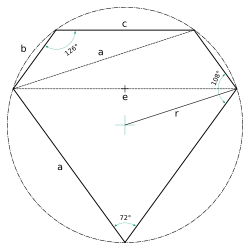Truncated rhombohedron
The truncated rhombohedron (also known as the truncated rhombohedron or Dürer's polyhedron ) is a special octahedral polyhedron , which is depicted on Albrecht Dürer's copperplate Melencolia I from 1514.
description
The truncated rhombohedron is a convex , octahedral polyhedron. It is made up of six equal, irregular, but axially symmetrical pentagons and two equilateral triangles . It has twelve corners; three faces meet at each corner (a triangle and two pentagons or three pentagons). All corner points lie on the same sphere . Opposite faces are parallel . In the stitch, the body stands on a triangular surface , the pentagons virtually form the surface . The number of edges is eighteen.
construction
The original body is a hexahedral rhombohedron , which is parallelepiped and oblique prism at the same time . It consists of six diamonds with the edge length and the characteristic angles 72 ° and 108 °. Six of its eight corners lie on a common sphere, the two points protrude beyond it. By cutting off the tips at the correct height, three new corners are created which form the triangular sides of the truncated rhomboid and which also lie on the common circumference. As usual, the cut surfaces are perpendicular to the contour line of the body.
Pentagonal side faces
By cutting off, the diamonds become the pentagonal boundary surfaces of the truncated rhomboid, two of the diamond sides (red) are retained with the included angle of 72 °, the other two sides are reduced to (blue), the cutting line (green) runs parallel to the diagonal (see graphic on the right). The two newly added obtuse angles are each 126 °. In particular, and are (still) parallel and all five corners lie on a perimeter and thus contain three different chordal quadrilaterals (as well as two reflections). See also: tendon pentagon .
This special choice of angles for the rhombuses creates several remarkable proportions in the pentagonal side surfaces of the truncated rhomboid. It is the radius radius of the pentagon:
- The following aspect ratios are in the golden ratio : .
- is at the same time difference and geometric mean of and :
- The two secondary diagonals, which each form a triangle with and , are exactly the same length . Together with the other edges, they each result in a mirror-symmetrical trapezoid whose mirror axis does not match that of the pentagon.
Formulas
For the polyhedron
| 3D construction of the Dürer polyhedron - based on the formulas below. |
| Sizes of the truncated rhomboid with the longest edge a | |
|---|---|
| volume | |
| Surface area | |
| Umkugelradius | |
|
1. Face angle (pentagons above edge a ) ≈ 103 ° 39 ′ 17 ″ |
|
|
2. Face angle (pentagons above edge b ) ≈ 76 ° 20 ′ 43 ″ |
|
|
3. Face angle (pentagon - trine ) ≈ 114 ° 48 ′ 4 ″ |
|
For individual side surfaces
|
|
||||||||||||||||||||||
literature
- Eberhard Schröder: Dürer, art and geometry: Dürer's artistic work from the point of view of his “Underweysung” . Birkhäuser, Basel 1980, ISBN 3-7643-1182-7 , especially chapter: Reconstruction analysis on the copper engraving "Melancholie" , pp. 64–75, there also a sketch sheet of the preliminary study on p. 69.
Web links
- Eric W. Weisstein : Dürer's Solid . In: MathWorld (English).

























